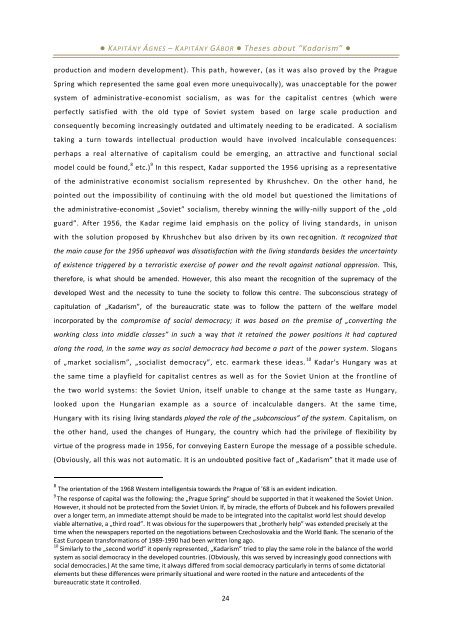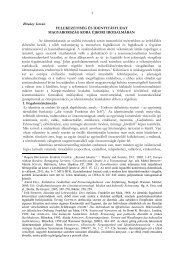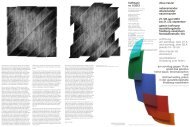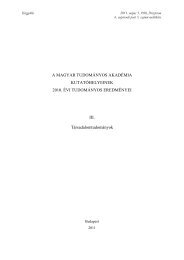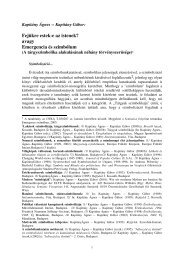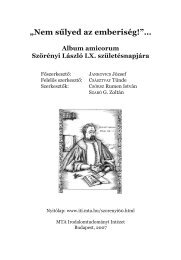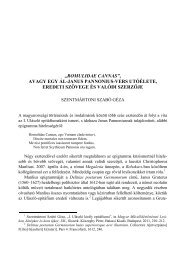symbolic elements of everyday culture - MTA Szociológiai ...
symbolic elements of everyday culture - MTA Szociológiai ...
symbolic elements of everyday culture - MTA Szociológiai ...
Create successful ePaper yourself
Turn your PDF publications into a flip-book with our unique Google optimized e-Paper software.
● KAPITÁNY ÁGNES – KAPITÁNY GÁBOR ● Theses about “Kadarism” ●<br />
production and modern development). This path, however, (as it was also proved by the Prague<br />
Spring which represented the same goal even more unequivocally), was unacceptable for the power<br />
system <strong>of</strong> administrative-economist socialism, as was for the capitalist centres (which were<br />
perfectly satisfied with the old type <strong>of</strong> Soviet system based on large scale production and<br />
consequently becoming increasingly outdated and ultimately needing to be eradicated. A socialism<br />
taking a turn towards intellectual production would have involved incalculable consequences:<br />
perhaps a real alternative <strong>of</strong> capitalism could be emerging, an attractive and functional social<br />
model could be found, 8 etc.) 9 In this respect, Kadar supported the 1956 uprising as a representative<br />
<strong>of</strong> the administrative economist socialism represented by Khrushchev. On the other hand, he<br />
pointed out the impossibility <strong>of</strong> continuing with the old model but questioned the limitations <strong>of</strong><br />
the administrative-economist „Soviet” socialism, thereby winning the willy -nilly support <strong>of</strong> the „old<br />
guard”. After 1956, the Kadar regime laid emphasis on the policy <strong>of</strong> living standards, in unison<br />
with the solution proposed by Khrushchev but also driven by its own rec ognition. It recognized that<br />
the main cause for the 1956 upheaval was dissatisfaction with the living standards besides the uncertainty<br />
<strong>of</strong> existence triggered by a terroristic exercise <strong>of</strong> power and the revolt against national oppression. This,<br />
therefore, is what should be amended. However, this also meant the recognition <strong>of</strong> the supremacy <strong>of</strong> the<br />
developed West and the necessity to tune the society to follow this centre. The subconscious strategy <strong>of</strong><br />
capitulation <strong>of</strong> „Kadarism”, <strong>of</strong> the bureaucratic state was to follow the pattern <strong>of</strong> the welfare model<br />
incorporated by the compromise <strong>of</strong> social democracy; it was based on the premise <strong>of</strong> „converting the<br />
working class into middle classes” in such a way that it retained the power positions it had captured<br />
along the road, in the same way as social democracy had become a part <strong>of</strong> the power system. Slogans<br />
<strong>of</strong> „market socialism”, „socialist democracy”, etc. earmark these ideas. 10 Kadar's Hungary was at<br />
the same time a playfield for capitalist centres as well as for the Soviet Union at the frontline <strong>of</strong><br />
the two world systems: the Soviet Union, itself unable to change at the same taste as Hungary,<br />
looked upon the Hungarian example as a sourc e <strong>of</strong> incalculable dangers. At the same time,<br />
Hungary with its rising living standards played the role <strong>of</strong> the „subconscious” <strong>of</strong> the system. Capitalism, on<br />
the other hand, used the changes <strong>of</strong> Hungary, the country which had the privilege <strong>of</strong> flexibility by<br />
virtue <strong>of</strong> the progress made in 1956, for conveying Eastern Europe the message <strong>of</strong> a possible schedule.<br />
(Obviously, all this was not automatic. It is an undoubted positive fact <strong>of</strong> „Kadarism” that it made use <strong>of</strong><br />
8 The orientation <strong>of</strong> the 1968 Western intelligentsia towards the Prague <strong>of</strong> '68 is an evident indication.<br />
9 The response <strong>of</strong> capital was the following: the „Prague Spring” should be supported in that it weakened the Soviet Union.<br />
However, it should not be protected from the Soviet Union. If, by miracle, the efforts <strong>of</strong> Dubcek and his followers prevailed<br />
over a longer term, an immediate attempt should be made to be integrated into the capitalist world lest should develop<br />
viable alternative, a „third road”. It was obvious for the superpowers that „brotherly help” was extended precisely at the<br />
time when the newspapers reported on the negotiations between Czechoslovakia and the World Bank. The scenario <strong>of</strong> the<br />
East European transformations <strong>of</strong> 1989-1990 had been written long ago.<br />
10 Similarly to the „second world” it openly represented, „Kadarism” tried to play the same role in the balance <strong>of</strong> the world<br />
system as social democracy in the developed countries. (Obviously, this was served by increasingly good connections with<br />
social democracies.) At the same time, it always differed from social democracy particularly in terms <strong>of</strong> some dictatorial<br />
<strong>elements</strong> but these differences were primarily situational and were rooted in the nature and antecedents <strong>of</strong> the<br />
bureaucratic state it controlled.<br />
24


